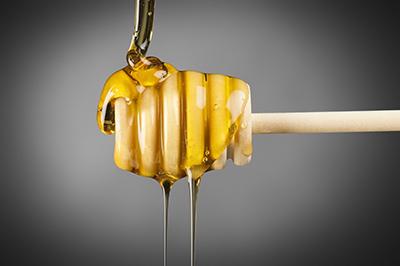Honey’s Sweet Benefits

(Photo by Anthia Cumming, courtesy of Getty Images)
Foodborne pathogens, which can encompass viruses, bacteria, and parasites, can cause foodborne illnesses when consuming a meal that has been contaminated. There are an estimated 48 million cases of foodborne illnesses every year. A commonly known pathogen that fits into this category is Enterotoxigenic Escherichia coli (ETEC), which infects the small intestine causing diarrhea and other consequences to the person infected.
ARS scientists, in collaboration with the National Honey Board, are examining the way honey affects the gut microbial community and possibly assists it in resisting infection by the foodborne pathogen ETEC. To begin their studies, both pathogen and honey were put through a model of the stomach to better represent how the study components would interact with each other during human consumption. ETEC has a tolerance to acidic environments and honey is naturally acidic, as is the stomach. Therefore, all of honey’s bioactive compounds and anti-microbial components are used to working in that kind of environment.
“We have to put ETEC through the stomach because it's going to change how it behaves once it's exposed to that acidity,” explained Ste Traxler, a graduate student researcher at the Western Human Nutrition Research Center in Davis, CA.
The choice to use honey was not only due to its natural acidic nature, but also because of the accessibility of this food. The particular honey utilized in this research project was clover honey, which is available in supermarkets.
“So, the plants that the bees are collecting their nectar from determine your honey type,” explained Traxler, “and that will also determine a lot of those bioactive components.”
Honey is also being used in some hospitals as a way to prevent infections, particularly in hospital’s burn wards, because of the need for having protection for the broken skin barrier from outside bacteria that could pose as a threat. The more hydrogen peroxide in the honey, the more it is effective as a topical antimicrobial. The honey with the highest concentration of methylglyoxal, a natural potent anti-microbial, is Manuka honey.
Manuka honey comes from the Manuka tree, which is native to New Zealand. Sometimes this tree is referred to as the New Zealand tea tree because both the Manuka and Tea Tree produce oils with similar properties and come from the same plant family. All types of honey have some level of concentration of methylglyoxal, while also having other micronutrients that contain antioxidant and anti-inflammatory properties.
Foods like lettuce, Brussel sprouts, and spinach may become contaminated with E. coli. It’s important to notice that these items are typically ingested without cooking them, which causes the risk of exposure to foodborne pathogens like E. coli to heighten. This is one of the reasons researchers are studying how honey can help prevent infection after ingesting contaminated food.
Honey has a lower glycemic index than standard table sugar (sucrose). Therefore, ARS scientists are also investigating whether the benefit of reduced metabolic stress that comes from sugar consumption also occurs when consuming honey in the context of a snack with the added benefit of consuming a healthier option. Another benefit seen from honey is that, so far, there hasn’t been any bacterial resistance observed from it, the same way that happens with antibiotics. For these reasons, researchers are learning how honey can positively affect our digestive health and help us obtain protection against pathogens and bacteria. By Olga Vicente, ARS’s Office of Communications.
You May Also Like:

